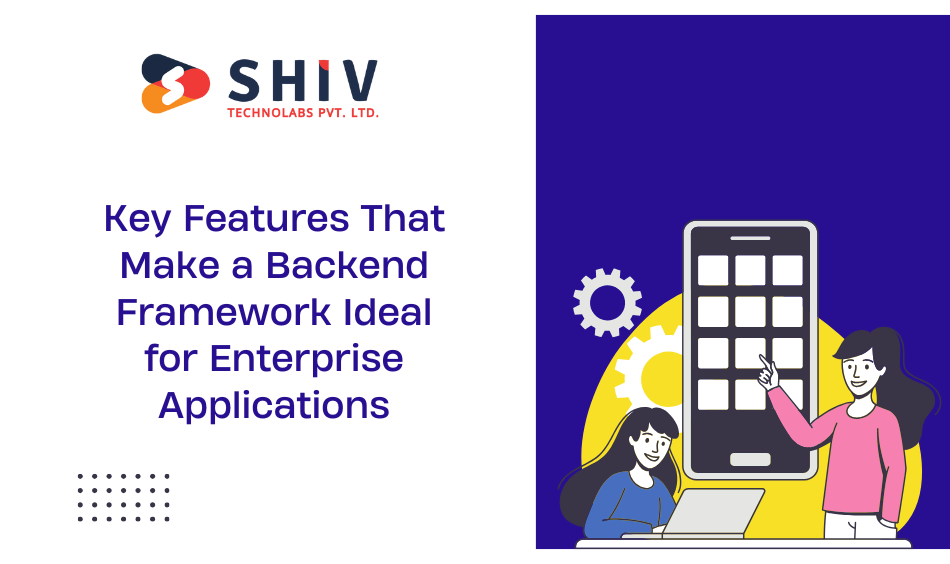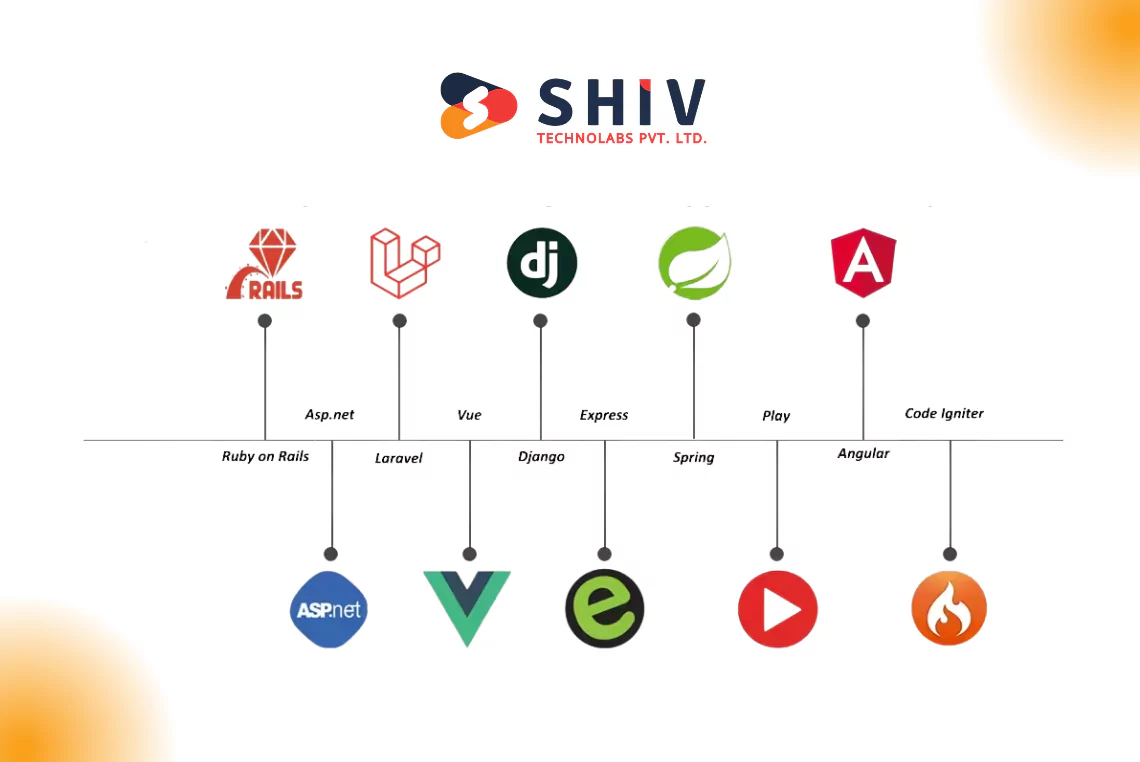Table of Contents
In 2025, backend frameworks are essential for creating robust, scalable, and secure enterprise applications. These frameworks provide the foundation for businesses to build sophisticated systems that can handle high traffic, large data sets, and complex functionalities. As technology continues to evolve, selecting the right backend framework is more critical than ever to meet the demands of modern enterprises.
The transition to microservices, cloud environments, and AI integration has changed the way backend systems are designed and developed. In this blog, we’ll explore the best backend frameworks for enterprises in 2025 and the factors that influence the choice of the right backend solutions.
Key Features That Make a Backend Framework Ideal for Enterprise Applications

When building enterprise applications with a backend framework plays a crucial role in ensuring that the backend solutions for enterprises are stable, scalable, secure, and efficient. Selecting the right backend framework for an enterprise is a decision that affects everything from performance to long-term viability. Here are the key factors that make a backend framework suitable for enterprise use:
1. Scalability
A suitable backend framework should support growth without sacrificing performance. It should allow horizontal scaling by distributing workloads across multiple servers and vertical scaling by handling more resources on a single server.
2. Security
Security is a top priority in enterprise applications. A strong backend framework includes built-in features to prevent common vulnerabilities such as SQL injections, XSS, and CSRF, along with robust authentication and authorization mechanisms to safeguard sensitive data.
3. Performance
Efficient performance is critical for enterprises dealing with large volumes of data or high user traffic. The backend framework must handle requests quickly, process data efficiently, and maintain low latency, ensuring a smooth user experience even under high loads.
4. Flexibility and Customization
Enterprises often require tailored solutions. A flexible backend framework supports customization, allowing developers to adapt it to unique business needs and long-term goals.
5. Integration Capabilities
The ability to integrate seamlessly with databases, external systems, and third-party services is vital. This enables smooth workflows and connectivity across platforms.
6. Community Support and Documentation
A framework with strong community support and clear documentation helps developers troubleshoot issues and accelerate learning, significantly reduce development time, and ensure ongoing support.
7. Long-Term Viability
Enterprises need frameworks that are continuously updated with new features, security patches, and performance improvements. Frameworks with strong development communities and clear roadmaps are essential for long-term support, ensuring the application remains secure and functional over time.
8. Cost-Effectiveness
Choosing a cost-effective framework is vital for managing development expenses. Enterprises must consider both initial costs and long-term maintenance. Frameworks with built-in tools and libraries can reduce development time, while ongoing support and community-driven resources can lower maintenance costs.
9. Reliability and Availability
For mission-critical applications, reliability is essential. A framework should support high availability and fault tolerance, with features like load balancing and automatic failover to ensure the system runs smoothly even during high traffic or server failures.
10. Developer Productivity
A good framework should improve developer productivity by offering clear coding standards, built-in libraries, and automated testing tools. This allows teams to focus on building application features instead of managing the framework itself, speeding up development and reducing errors.
By considering these factors, enterprises can select the best framework to support their growth and ensure reliable, cost-effective, and efficient applications.

Top 10 Backend Frameworks for Enterprise Applications in 2025
As businesses increasingly depend on robust enterprise backend systems to drive their operations, selecting the right framework is crucial for building efficient, secure, and scalable applications. The following backend frameworks are expected to play a pivotal role in enterprise application development in 2025, each offering unique features and advantages to meet the diverse needs of businesses.
1. Laravel
Laravel is a PHP-based framework known for its elegant syntax and extensive built-in tools. It simplifies complex tasks such as routing, authentication, and database management, making it a popular choice for building feature-rich web applications. Its modular structure and large community support provide businesses with a flexible and customizable platform for developing enterprise applications.
Key Features of Laravel
- Excellent for rapid development.
- Built-in features like routing, authentication, and session management.
- Strong community support and documentation.
Use Cases: Ideal for developing customer relationship management (CRM) systems, content management systems (CMS), and e-commerce platforms.
Also Read: Why Laravel is The Best Framework for Start-up Growth?
2. Django
Django is a high-level Python framework that emphasizes simplicity and rapid development. Its built-in features—such as user authentication, security protections, and an admin interface—make it a great choice for businesses looking for a quick, scalable solution.
Key Features of Django
- Strong security features and protection against common vulnerabilities.
- Highly scalable and suitable for large applications.
- A large ecosystem of reusable components and libraries.
Use Cases: Frequently used in eCommerce, content management, and enterprise-grade solutions where rapid deployment and security are critical.
Also Read: Django: The Preferred Framework for Fast Web Development in USA
3. ExpressJS
ExpressJS is a minimalist and flexible web framework built on Node.js. It is lightweight, making it suitable for building fast and scalable APIs and real-time applications. Its non-blocking, asynchronous nature allows it to handle a high number of concurrent requests, which is essential for high-traffic enterprise applications.
Key Features of ExpressJS
- Lightweight and fast.
- Great for building APIs and microservices.
- Asynchronous, event-driven architecture for handling real-time data.
Use Cases: Best suited for real-time applications, RESTful APIs, and single-page applications (SPAs).
4. ASP.Net
ASP.Net, developed by Microsoft, is a powerful, high-performance backend framework designed for building web applications and services. It supports cross-platform development, making it ideal for enterprises that need to create scalable, cloud-based applications with strong security requirements.
Key Features of ASP.NET
- High performance and scalability.
- Cross-platform capabilities, ideal for cloud-based applications.
- Strong support for enterprise-level security.
Use Cases: Commonly used for large-scale enterprise applications, especially in sectors like finance, healthcare, and e-commerce.
Also Read: 5 Programming Languages For Creating E-Commerce Websites
5. NestJS
NestJS is a progressive Node.js framework built with TypeScript. It is designed for building scalable and maintainable server-side applications, making it an excellent choice for enterprises that need modular, highly decoupled backend systems. NestJS’s architecture draws on the best practices of Angular, providing a familiar structure for developers with front-end experience.
Key Features of NestJS
- Built-in support for TypeScript, providing better maintainability and scalability.
- Modular architecture for building large-scale applications.
- Strong support for microservices and GraphQL.
Use Cases: Ideal for building enterprise applications requiring scalability, modularity, and microservices architecture.
6. Bootstrap
While Bootstrap is traditionally known as a frontend framework, it also provides tools for building backend components with HTML, CSS, and JavaScript. By integrating Bootstrap into the backend, enterprises can improve the user interface and enhance the overall user experience, especially for applications with a web-based frontend.
Key Features of Bootstrap
- Fast and responsive design for front-end development.
- Integration with backend systems to enhance the user interface.
- Easy to use with predefined UI components and templates.
Use Cases: Best suited for applications that need both backend and frontend functionality with a consistent, responsive design.
7. Blazor
Blazor is a web framework from Microsoft that allows developers to build interactive web applications using C# and .NET instead of JavaScript. This framework allows enterprises to share code across the front end and back end, improving efficiency and reducing development time. It is particularly well-suited for developers already familiar with .NET technologies.
Key Features of Blazor
- Shared code between frontend and backend, reducing duplication.
- Support for both client-side and server-side web applications.
- Integration with .NET and Microsoft’s ecosystem.
Use Cases: Ideal for enterprises using .NET technologies and seeking to build interactive, modern web applications.
8. Phoenix
Phoenix is a web development framework built on the Elixir programming language, designed for building scalable and reliable applications. It provides real-time features and a high level of concurrency, making it suitable for applications that require performance under heavy loads.
Key Features of Phonix
- Excellent for real-time applications and systems with high concurrency needs.
- Fault-tolerant and highly scalable.
- Functional programming paradigm with high-level abstractions.
Use Cases: Great for high-performance applications, real-time systems, and applications requiring high availability and fault tolerance.
9. FastAPI
FastAPI is a modern Python framework for building APIs, designed to be fast, efficient, and easy to use. It supports asynchronous programming and automatic data validation, making it ideal for enterprises that need high-performance backend systems.
Key Features of FastAPI
- Very high performance due to asynchronous support.
- Automatic data validation and documentation generation.
- Excellent for building RESTful APIs quickly.
Use Cases: Ideal for building high-performance APIs, microservices, and systems that require real-time data processing.
Also Read: How to Develop Python APIs Fast and Simple – Trends, Tips, and Tools for 2025
10. Koa
Koa is a minimalist framework created by the team behind ExpressJS. It is designed for building robust APIs and web applications with a focus on performance and flexibility. Koa allows developers to build applications with a minimalistic approach while still providing the necessary tools for modern backend development.
Key Features of Koa
- Lightweight and highly flexible.
- Asynchronous and non-blocking, optimized for handling multiple requests.
- Middleware support for enhanced functionality.
Use Cases: Great for building REST APIs, microservices, and web applications that require a lightweight, highly flexible backend.
The backend frameworks mentioned above are equipped with features that cater to a wide range of enterprise needs, from scalability and security to real-time performance and flexibility. Enterprises looking to build robust, scalable, and secure applications should evaluate these frameworks based on their specific requirements, such as the size of the application, development resources, and long-term goals.
By carefully considering factors like integration capabilities, developer productivity, and support for emerging technologies, businesses can select the best backend framework that aligns with their objectives in 2025.

How to Choose the Right Backend Framework for Your Enterprise
Selecting the right backend framework is vital for building scalable and efficient enterprise applications. Here’s a concise guide to help you evaluate and choose the right framework for your business.
1. Assess Your Business Goals and Application Requirements
The first step in choosing the right backend framework is identifying your business goals and the specific requirements of the application. Consider:
- Traffic volume and performance: Choose frameworks that scale well and perform efficiently under heavy traffic.
- Data handling: For data-intensive applications, select frameworks with strong data management capabilities.
- Real-time requirements: If your app requires real-time interaction, ensure the framework supports asynchronous processing.
2. Evaluate Team Expertise and Learning Curve
Your development team’s expertise and experience with a particular programming language or framework can play a significant role in the selection process. While some frameworks may offer ease of use and faster development cycles, others might have a steeper learning curve but offer more powerful features and scalability. Consider:
- Development speed vs. learning curve: If your team is familiar with a specific programming language or framework, the development process may be faster. On the other hand, if your team is open to learning new technologies, a more complex framework may offer long-term benefits.
- Framework support and resources: Frameworks with strong community support, documentation, and available plugins help reduce the learning curve and speed up development.
3. Scalability and Long-Term Viability
Scalability is a critical factor when choosing a backend framework. As your business grows, so will the need to scale your application. The selected framework should be capable of handling increased user loads, database traffic, and complex integrations without compromising performance. Choose a framework that supports:
- Horizontal scaling: For applications that need to handle increasing users or data traffic.
- Vertical scaling: For optimizing resource usage on a single server. Additionally, ensure the framework has ongoing support and updates to avoid obsolescence.
4. Consider Integration Capabilities
Enterprise applications often need to integrate with third-party tools, databases, and external APIs. The backend framework you choose should allow seamless integration with other systems, enabling your application to interact with various services, platforms, and technologies. Key factors include:
- API management: Robust support for creating and managing APIs.
- Database compatibility: Ensure it integrates with your preferred database (SQL, NoSQL, etc.).
5. Budget and Resource Constraints
Budget plays a significant role in any project. While some frameworks are free and open-source, others may require paid licenses, support, or additional resources. It’s important to weigh the cost of implementing and maintaining the framework against the value it provides. Evaluate the costs involved in choosing a framework:
- Development and maintenance costs: Consider both initial implementation and long-term maintenance.
- Scaling costs: Assess future costs associated with scaling the system, including infrastructure and licensing.
By focusing on these key areas, you can select a backend framework that aligns with your business goals, supports growth, and fits within your budget.
Shiv Technolabs: Your Trusted Partner for Backend Development Services
At Shiv Technolabs, we provide top-notch backend development services to help businesses build reliable, scalable, and secure backend systems. Our team of experts utilizes cutting-edge technologies to ensure your applications perform efficiently, even as your business grows. From high-performance APIs to seamless integration with third-party services, we deliver backend solutions that align with your business goals.
Conclusion
The decision to select the right backend framework for enterprise application development is not one to be taken lightly. Factors such as business goals, scalability, integration capabilities, and budget all play crucial roles in determining which framework is best suited for your needs. Frameworks like Django, Spring Boot, Ruby on Rails, Express.js, and Laravel offer diverse features to meet a wide range of enterprise needs.
By evaluating the factors mentioned in this guide, enterprises can make a more informed decision when selecting a backend framework that aligns with their goals. Whether you are building a real-time application, a microservices-based solution, or a data-intensive enterprise system, the right backend framework can make all the difference in ensuring the success of your project.
If your enterprise needs enterprise-grade backend development solutions, Shiv Technolabs offers expert backend development services to help you choose and implement the perfect backend solutions for your business. Contact our experts now!




















